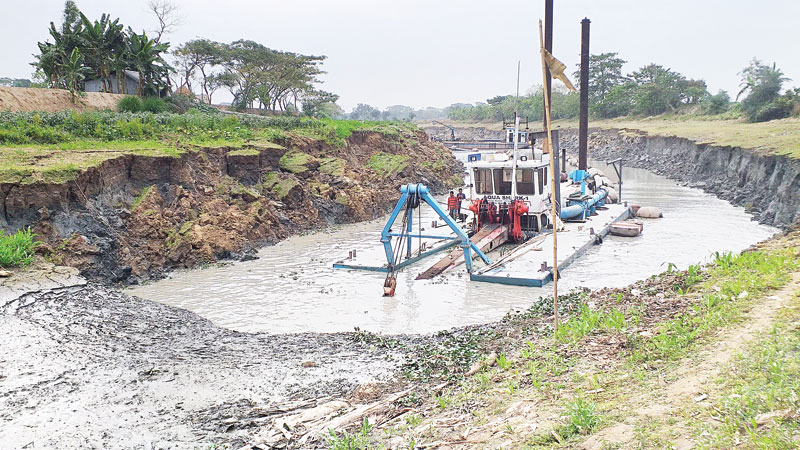FT Online
Published:2019-03-31 20:28:48 BdST
7 river routes ‘restored’ thru dredging
This recent photo shows a BIWTA dredger clearing the bed of the Raksha Nala, a dead river, in Taherpur of Sunamganj district to restore the waterway and connect the Surma and the Rakti rivers.
The Bangladesh Inland Water Transport Authority (BIWTA) has reclaimed about 1,000 acres of fallow land with dredge spoil, while 915 km of waterways have been made navigable at a cost of Tk 936 crore. Besides, hundreds of poor farmers have become self-reliant by cultivating fish, ducks, cattle and doing other water-dependent businesses, as water is now available round the year. According to BIWTA sources, poor farmers are cultivating fruits like water melon, vegetables and rice on reclaimed lands. The project, in the first phase, is being implemented for 24 important inland rivers under the ‘capital dredging on 53 important inland rivers’ programme, which started in 2012 and is scheduled to be completed in 2021.
The BIWTA has already restored 915 km of waterways, spending Tk 936 crore out of a total Tk 1,923 crore, Saidur Rahman, additional chief engineer (Dredging) of BIWTA, told The Independent.
“We have already completed seven river routes under the project. The completed routes are Barishal-Jhalkathi-Barguna-Pathorghata river route, Bhairob Bazar-Lipsa-Chhatak-Sylhet route, Mongla-Ghasiakhali route, Ghasiakhali-Barishal-Kaliganj-Chandour-Aricha route, Khulna-Gazirhat-Bardia-Manikda route, Mirpur-Savar route, Syedpur-Bandur and Barishal-Patuakhali-Mirzaganj river route,” Rahman said.
A total of 495 lakh cubic metres of silts out of total 997 lakh cubic metres have so far been removed, he said, adding that rice production has also increased in some areas of Sunamganj, Barguna, Jhalkathi, Khulna, Bagerhat, Netrokona, Kishoreganj, Gopalganj, Cumilla and Patuakhali districts.
“The farmers are now using river waters round the year to irrigate their farmlands. They didn’t get water before the dredging of the rivers,” Rahman said in reply to a query.
According to the BIWTA official, the dredging has not only increased the water flow in the rivers concerned but has also helped in restoring the environmental balance.
The water level has risen and natural water reservoirs have been created in many areas too, he added.
“Fishermen can catch fish round the year in those water-bodies. Besides, traders can transport their goods by waterways round the year,” Rahman said. The BIWTA official alleged that they were facing some problems to continue their dredging work, a priority of project of Prime Minister Sheikh Hasina.
“It has taken one year to begin dredging work in the Manu River after taking up the project because of the lease given by the district administration for lifting sand. Dredging of the Kaliganga River in Manikganj was suspended for one year due to local problems. The dredging work of the rivers Atrai in Dinajpur, Bogai and Kangsha in Sherpur district is being delayed as the survey work is taking a long time,” Rahman said in reply to a query. Besides, work on the Savar-Zabra river route could not be started due to the interference of the local people, he added.
Saidur Rahman hoped that they would be able to complete the first phase of dredging of the remaining 13 river routes by 2021.
Regarding the dredging work of the protocol routes between Bangladesh and India, the BIWTA official said, “The survey work of 285 km of the Ashuganj-Jokiganj route of Kushiara River and 178 km of Sirajganj-Doikhawa route of the river Brahmaputra has been completed.”
The dredging work of these protocol routes will begin soon, Rahman said in reply to a query.
Unauthorized use or reproduction of The Finance Today content for commercial purposes is strictly prohibited.


